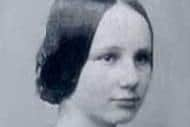The genius of Ada Lovelace, and her Seaham roots
and live on Freeview channel 276
Our story starts with one of western literature’s most famous names. George Gordon Byron, 6th Baron Byron – Lord Byron and Annabella Milbanke, the only woman unfortunate enough to become his wife.
But for International Women’s Day we remember the life of their celebrated daughter; the genius that was Ada Lovelace
Early life


Advertisement
Hide AdAdvertisement
Hide AdIn 1812 Byron had an affair with the married (to future Prime Minister George Lamb) Lady Caroline Lamb, who famously described the poet as “Mad, bad and dangerous to know.”
Annabella therefore couldn’t say she wasn’t warned. Were it not for his title and his undoubted poetic talent, Lady Caroline might with equal accuracy have referred to him as toe-rag.
Annabella was born in County Durham in 1792. History remembers her mainly as Byron’s wife, which is a tad unfair.
She was highly intelligent and very well educated with a particular gift for mathematics. In an era when the duties of most women of her class extended to giving birth and agreeing with men, this was quite notable.
Advertisement
Hide AdAdvertisement
Hide AdThe Milbanke family home was Seaham Hall, now a spa hotel. It was built by Annabella’s parents in 1791 and still has an Annabella Room today. Byron first visited the hall in 1814 by which time the couple were officially courting.
Unofficially he was also “courting” a number of other women. Nevertheless, the pair were married there on January 2, 1815. It’s likely that their daughter was conceived there. Ada was born on December 10.
As expected, Byron was a wash-out as a husband and father. His temper, drinking and affairs led to the deeply religious Annabella leaving him when Ada was weeks old. The infant had already annoyed him by having the unmitigated gall to be a girl.
Ada would never know Byron. He died of a fever in Missolonghi in 1824 while fighting for Greek independence from the Ottomans. He was refused burial in Westminster Abbey as they didn’t want the likes of him in there.
Charles Babbage and the “Analytical Engine”
Advertisement
Hide AdAdvertisement
Hide AdSo much for Ada’s dad then. But she wasn’t close to her mother either and was brought up mainly by her maternal grandmother, Lady Judith Milbanke. Annabella, who was highly moral (according to her own terms,) once referred to her daughter as “it” in a letter to Judith.
A complex woman, Annabella was committed to prison reform, the abolition of slavery and still Byron, long after he had died. There was little room for Ada.
During Ada’s time universities were closed to women. Evidently the brain was not considered to be the most important organ. However, while talent can be suppressed, genius can not. She inherited her mother’s gift for mathematics and learned it from the age of four.
She received private education from some of the leading eggheads and boffins of the day in maths and other sciences.
Advertisement
Hide AdAdvertisement
Hide AdIn 1833 when she was 17 she met Charles Babbage, who is generally credited with inventing the computer which would evolve into the machines we know today. Babbage was immediately impressed by her intellect and quite incredible brainpower.
He had created his “Analytical Engine” by the 1840s and Ada wrote prodigious notes to explain it. Some scientists could not even grasp the difference between the Analytical Engine and its predecessor the Difference Engine. Thickos.
We’ll be honest and say that knocking on 200 years later, a few journalists are struggling to keep up with Babbage and Lovelace. Put simply (we think it’s best, for us), Ada discovered how to calculate numerical sequences using the Analytical Engine, in essence making her arguably the world’s first computer programmer.
She had worked out that numbers could represent something other than quantity, effectively inventing the computer algorithm. She also envisaged musical streaming. This was one serious clever-clogs and her legacy not only continues, it expands.
Decline
Advertisement
Hide AdAdvertisement
Hide AdAda suffered from ill health for most of her short life. She died from uterine cancer in November 27, 1852 aged just 36. She passed away at the same age as her father, but predeceased her distant mother by eight years.
She was buried beside Byron in a churchyard in Hucknall, Nottinghamshire. This may surprise some, but she was always fascinated by the father she never knew as well as his work. Her eldest son was named Byron.
Her deathbed was attended by Charles Dickens, who read her a passage from Dombey and Son. By then she was separated from her husband, the First Earl of Lovelace. They had three children.
She was not wealthy at her passing having lost a good deal of her money on the horses, including a single £3,200 bet on the Derby (about £350,000 today).
Legacy
Advertisement
Hide AdAdvertisement
Hide AdAda Lovelace is well known, even if she didn’t really receive any recognition until a century after her death. She has been portrayed in fiction a number of times, including in a 2020 appearance in Doctor Who.
But she isn’t anything like as celebrated as her illustrious father, which seems unfair. We can only speculate on what 21st century life would be like without her.
How would life be if Lord Byron had never written Don Juan? Poorer, certainly. Not radically different though.
As Oscar Wilde said: “All art is quite useless.” Computers aren’t. Yet Byron’s fame still eclipses that of his daughter and Charles Babbage.
Advertisement
Hide AdAdvertisement
Hide AdThese days when we perform any of the multitudinous tasks which require computer programming, as people do globally, we should perhaps spare a little thought for Ada Lovelace.
Then remember that it all began in Seaham.
